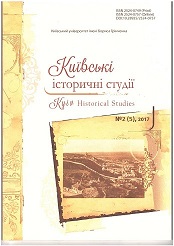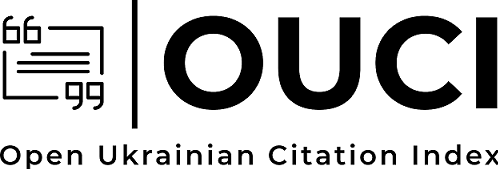CAMP OF UNA INTERNED TROOPS IN PIKULICE, POLAND (JANUARY — FEBRUARY, 1921): CONDITIONS OF STAY AND SOLDIERS’ MORALE
DOI:
https://doi.org/10.28925/2524-0757.2017.23Keywords:
Camp, internees, nutrition, hospital, UNA, Pikulicе.Abstract
The article analyses the conditions of stay and morale of interned soldiers of UNA in the camp of Pіkulicе (Poland). It is proved that the life of Ukrainian soldiers was marked by considerable difficulties, caused by overcrowding of the camp, lack of firewood for heating huts, inefficient work of sanitary facilities, extremely poor food and other restrictions. All these led to a significant increasing the incidence rate in the camp, but thanks to well-established medical care, the spread of infectious diseases were quickly localized. But all the same, these factors in a complex led to the demoralization of those Ukrainian soldiers, who did not have stable national-state convictions. In these conditions, the efforts of senior military commanders and employees of cultural and educational departments to strengthen the morale of interned persons became of great importance. For this purpose, in the camp it was organized special courses for increasing the middle level of education of the Cossaks. For the same purpose it was arranged the library and reading room for 50-60 people in the camp. Members of publishing section put great effort into publishing scientific periodical “Zaporozhets”, and satirical magazine, distributed in the barracks. It was created conditions for sport activity among interned soldiers. In their free time soldiers went to the amateur Ukrainian theatre.
Downloads
References
Vishka, O. (2002). Presa ukraínskoi emígratsii v Polshchí (1920–1939 rr.). Ístoryko-bíblíohrafíchne doslídzhennia. Lviv (in Ukrainian).
Kolianchuk, O. (1995). Ukraintsi v taborakh Peremyshlia (1918–1921). Pamiatky Ukrainy: istoriia ta kultura, 3, 112–117 (in Ukrainian).ї
Kolianchuk, O. (2017). Tabir internuvannia ta ukrainske viiskove kladovyshche v Pykulychakh bilia Peremyshlia (1918–1921). Przemysl (in Ukrainian).
Pavlenko, M. I. (1999). Ukrainski viiskovopolonenni і internovani u taborakh Polshchi, Chekhoslovachchyny ta Rumunii: stavlennia vlady і umovy perebuvannia (1919–1924). Kyiv, 91 p. (in Ukrainian).
Sidorenko, N. (2000). Natsionalno-dukhovne samostverdzhennia: u 3-kh ch. Ch. II: Presa internovanykh ukraintsiv ta tsyvilnoi emihratsii (Chekhiia, Polshcha, Rumuniia, Yehypet, 1919–1924). Kyiv, 87 p. (in Ukrainian)
Sribniak, I. (1997). Obbezbroiena, ale neskorena: Internovana Armiia UNR u taborakh Polshchi i Rumunii (1921–1924). Kyiv-Philiadelphia, pp. 25–26, 64 (in Ukrainian).
Ukrainska revoliutsiia. Documenty 1919–1921. (1984). In edit. by T. Hunchak. New York, 395 p. (in Ukrainian).
Tsentralnyi Derzhavnyi Arkhiv vyshchykh Orhaniv ta upravlinnia Ukrainy (TsDAVO Ukrainy). F. 1078. Op. 2. Spr. 200 (in Ukrainian).
TsDAVO Ukrainy. F. 2439. Op. 2. Spr .28 (in Ukrainian).
TsDAVO Ukrainy. F. 1075. Op. 4. Spr. 28 (in Ukrainian).
TsDAVO Ukrainy. F. 3204. Op. 1. Spr. 12 (in Ukrainian).
TsDAVO Ukrainy. F. 2562. Op. 1. Spr. 32 (in Ukrainian).
TsDAVO Ukrainy. F. 2439. Op. 1. Spr. 189 (in Ukrainian).
TsDAVO Ukrainy. F. 3526. Op. 1. Spr. 1 (in Ukrainian).
Centralne Archіwum Wojskowe (CAW). Sprzymіerzona Armіa Ukraіńska. І.380.1. Т. 60 (Sprawozdanie statystyczne z pracy kulturalno-oswiatowej w obozach) (in Polish).
Karpus, Z. (1997). Jeńcy і іnternowanі rosyjscy і ukraіńscy na terenіe Polskі w latach 1918–1924. Toruń, 209 p. (in Polish).
Kolańczuk, O. (2017). Obóz internowania oraz ukraiński cmentarz wojenny w Pikulicach pod Przemyślem (1918–1921). Przemyśl, 51 p. (in Polish).
Published
How to Cite
Issue
Section
License
Copyright (c) 2018 Kyiv Historical Studies

This work is licensed under a Creative Commons Attribution-NonCommercial-ShareAlike 4.0 International License.
Authors who publish in this journal retain the right of authorship of the work and give to the journal right of first publication of this work under the conditions of Creative Commons: Attribution-NonCommercial-ShareAlike 4.0 International (CC BY-NC-SA 4.0), which allows others freely distribute the work published with reference to the authors of the original work and the first publication of this magazine.














